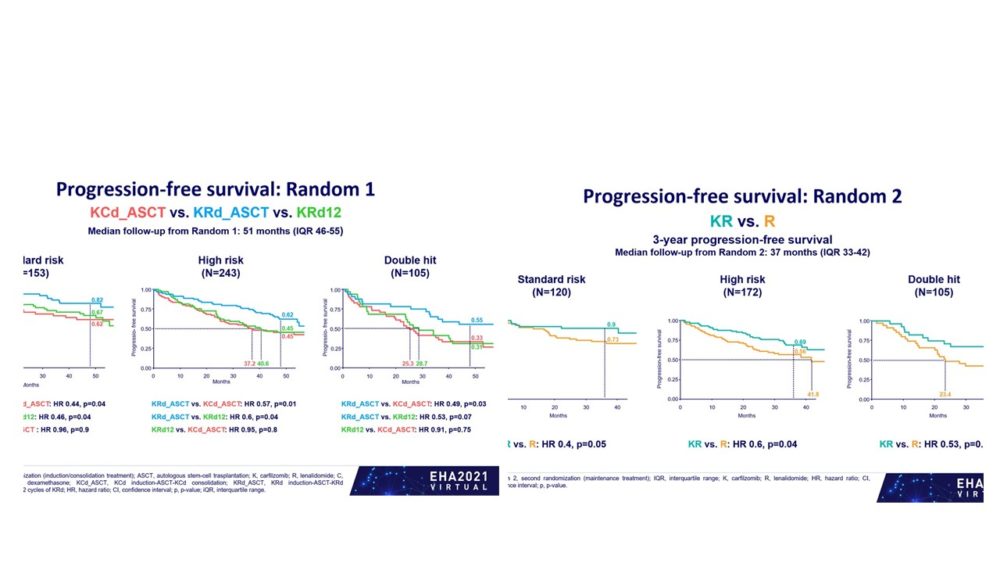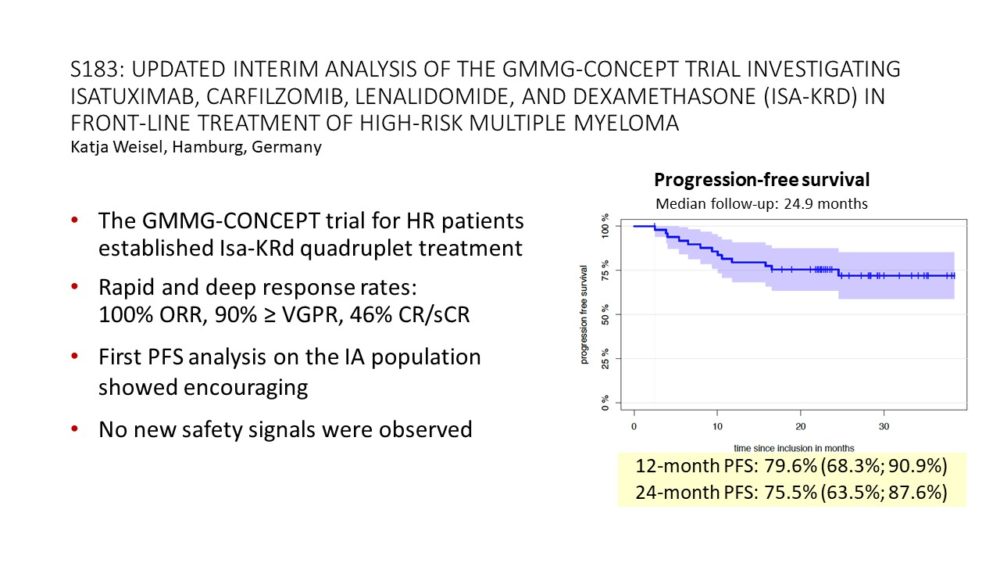Updates in the treatment of patients with high-risk myeloma
Efstathios Kastritis, MD
National and Kapodistrian University of Athens
Several studies evaluated new combinations for the treatment of myeloma patients who present with high risk characteristics (advanced ISS and high risk cytogenetics) and who may have quiet poor prognosis.
Prof M. Kaiser presented at both ASCO (abstract 8001) and EHA (Abstract S181), results from the OPTIMUM/MUKNINE trial in patients with ultra-high risk disease, as assessed by the presence of PCL or at least 2 high risk genetic lesions or high risk gene expression profiling. Patients were treated with a combination that included an induction with daratumumab plus cyclophosphamide, bortezomib, lenalidomide and dexamethasone (Dara-CVRD) for up to 6 cycles, followed by bortezomib augmented HD melphalan and ASCT followed by Dara-VRD consolidation for 6 cycles, then Dara-VR consolidation for 12 cycles and Dara-R maintenance until progression. 107 patients were enrolled, and 89 reached day 100-120 after ASCT. After ASCT, the ORR was 94% with 47% in CR and MRD negative (at 10-5) rate was 64%
Dr F. Gay (ASCO Abstract 8002) and Dr R.Mina (EHA Abstract S182) presented results focusing on high risk patients in an update of the FORTE trial, that compared carfilzomib-based induction (KRd or KCd) and consolidation with or without ASCT and lenalidomide or lenalidomide-carfilzomib (KR) maintenance. KRD induction with ASCT improved PFS in patients with standard risk or with high risk or with double hit (ultra-high risk) disease. The 4-year PFS among patients that were treated with KRD induction with ASCT was 82% in the standard risk vs 62% in the high risk and 55% in the double hit group; also, was associated with high rates of sustained 1-year MRD negativity in all groups including double hit. KR maintenance was also associated with improved 3-years PFS across risk groups vs lenalidomide alone. Notably, KRd induction with ASCT or KR maintenance did not show benefit in the subgroup of patients with amp1q.
Prof. K. Weisel presented in the EHA meeting (Abstract S183) the GMMG-CONCEPT trial (NCT03104842) which investigates Isatuximab-KRd combination in high risk newly diagnosed patients (with ISS-2 or -3 disease and high risk cytogenetics). In this updated interim analysis for PFS in 50 patients the ORR was 100% with 46% achieving sCR/CR after induction, 90% achieving at least VGPR while among assessed patients for the presence of MRD, 20/33 were MRDneg. After median follow up of ~25 months the 24-month PFS is 75.5%.
Why Become a Member
The International Myeloma Society is a professional, scientific, and medical society established to bring together clinical and experimental scientists involved in the study of myeloma. The purpose of this society is to promote research, education, clinical studies (including diagnosis and treatment), workshops, conferences, and symposia on all aspects of multiple myeloma worldwide.
The IMS is a membership organization comprised of basic research scientists, and clinical investigators in the field along with physicians and other healthcare practitioners.



